summary例子和答案
- 格式:doc
- 大小:38.00 KB
- 文档页数:10
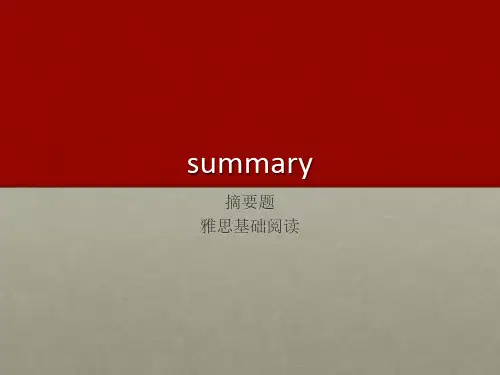

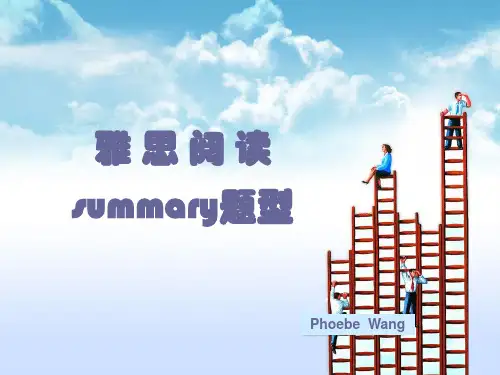
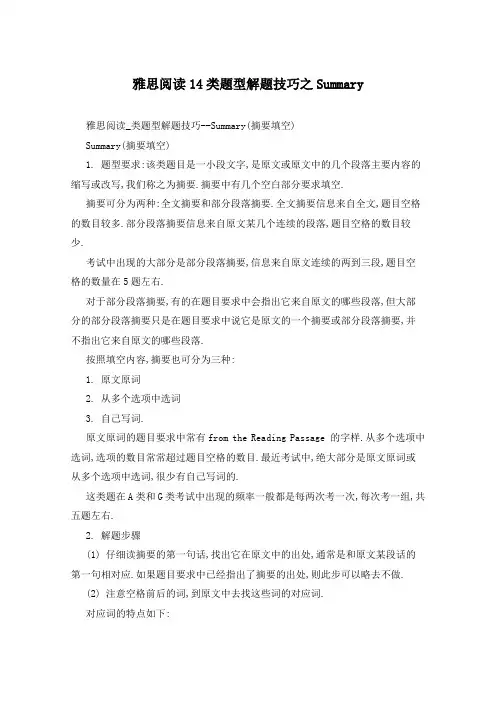
雅思阅读14类题型解题技巧之Summary雅思阅读_类题型解题技巧--Summary(摘要填空)Summary(摘要填空)1. 题型要求:该类题目是一小段文字,是原文或原文中的几个段落主要内容的缩写或改写,我们称之为摘要.摘要中有几个空白部分要求填空.摘要可分为两种:全文摘要和部分段落摘要.全文摘要信息来自全文,题目空格的数目较多.部分段落摘要信息来自原文某几个连续的段落,题目空格的数目较少.考试中出现的大部分是部分段落摘要,信息来自原文连续的两到三段,题目空格的数量在5题左右.对于部分段落摘要,有的在题目要求中会指出它来自原文的哪些段落,但大部分的部分段落摘要只是在题目要求中说它是原文的一个摘要或部分段落摘要,并不指出它来自原文的哪些段落.按照填空内容,摘要也可分为三种:1. 原文原词2. 从多个选项中选词3. 自己写词.原文原词的题目要求中常有from the Reading Passage 的字样.从多个选项中选词,选项的数目常常超过题目空格的数目.最近考试中,绝大部分是原文原词或从多个选项中选词,很少有自己写词的.这类题在A类和G类考试中出现的频率一般都是每两次考一次,每次考一组,共五题左右.2. 解题步骤(1) 仔细读摘要的第一句话,找出它在原文中的出处,通常是和原文某段话的第一句相对应.如果题目要求中已经指出了摘要的出处,则此步可以略去不做.(2) 注意空格前后的词,到原文中去找这些词的对应词.对应词的特点如下:A. 原词B. 词性变化;如空格前的词为threatening, 是形容词,原文中的词为threat, 是名词.C. 语态变化;一个是主动语态,一个是被动语态.D. 同义词;如空格前的词为throw away,原文中的词为discard(丢弃,抛弃,遗弃),它们是同义词.(3) 仔细阅读对应所在的句子,确定正确答案.(4) 注意语法,所填答案必须符合语法规定.(5) 注意顺序性,即题目的顺序和原文的顺序基本一致.NOTICE1. 注意题目要求中是否有字数限制.若要求从原文选词或自己写词,会有字数要求,如Use ONE OR TWO WORDS等,答案必须满足这个要求.2. 若从原文选词,只能选原文中连续的几个词,不能改变它们的顺序.如原文为virgin fibre, 发生答案不可能是fibre virgin.原文为 advances in the technology,答案不可能是technology advances.3. 若要求从原文选词,越是生词,越可能是答案.下列比较生僻的词如sustainable(可持续的).biodegradable(可生物降解的).contaminants(废物,杂物).nostrils(鼻孔)都是一些题目的答案.4. 从选项中选词,要注意看题目要求是写答案本身,还是写选项前的代表字母.选项前有代表字母的,肯定是要求答代表字母.最近的考试中,选项前大部分都有代表字母.5. 从选项中选词,答案与原文的六大对应关系.(1) 原文原词:与原文完全相同的词或短语.(2) 词性变化:原文为necessary,是形容词,选项为necessity,是名词.(3) 语态变化:原文为Governments have encouraged waste paper collection and sorting schemes,是主动语态.摘要中的句子为people have also beenencouraged by government to collect their waste on a regular basis,是被动语态.(4) 图表:如果原文中有图表,一般会有一题答案来自图表.(5) 同义词:原文为tight,选项为restricted,是同义词.(6) 归纳:有时文中没有直接提及,须从几句话中归纳出答案.一般比较难,目前考试中,至少有一个空格是归纳出来的.6.从选项中选词,如果时间不够,可以直接从选项中选择,不看原文.这时,要特别注意语法.这样做的准确性50%左右(视题目的难易及考生的水平而定).所以除非时间不够,否则不建议大家这样做.7. 如果要求自己写词,答案绝大部分是原文原词,少部分是对原文原词做的形式上的修改.要求自己写词的机率很小,遇到过一次.在这一次的5个题目中有4个答案是原文原词,剩下一个,原文原词是de-inked,答案根据语法的需要改为de-ink.雅思阅读机经真题解析--How to Achieve HappinessYou should spend about 20 minutes on Question 1-_ which are based on Reading Passage below.Throughout the whole period of one’s lifetime, the achieving of happiness can be seen as our ultimate and everlasting goal. Happiness is far more than a strong body, a magnificent villa or an around-the-world tour; it is something we need from our heart. However, we can investigate happiness through scientific methods.AWhen we are asked the question Where can we find happiness , it is a puzzle difficult to answer accurately. We can find happiness right in our own home, in our workplace, in school, in the company of our friends, etc. It is up to us to find the ways and means to achieve that happiness each of us seek and long for. However, it is essential to recognize that there is no one absolute way to achieve happiness. People may have different ideaswith regard to the ways of achieving happiness. The following five classifications are perceived by many people as sources of happiness: family and friends, wealth, position, educational achievement and fame.BTo give it a comprehensive definition, happiness is a mental state of well-being characterized by positive or pleasant emotions ranging from contentment to intense joy. A variety of biological, psychological, religious, and philosophical approaches have striven to define happiness and identify its sources. Various research groups, including Positive Psychology, endeavor to apply the scientific method to answer questions about what happiness is, and how we might attain it. While philosophers and religious thinkers often define happiness in terms of living a good life, or flourishing, rather than simply as an emotion. Happiness in this sense was used to translate the Greek Eudaimonia, and is still used in virtue ethics.CWhile the level of physical healthiness is the biggest determinant of happiness, comparison of financial success with others of the same age group is the second largest source of happiness and unhappiness. Financially richer people tend to be happier than poorer people, according to sociological researcher Glenn Firebaugh of Pennsylvania State University. Their research is focused on whether the income effect on happiness results largely from the things money can buy (absolute income effect) or from comparing one s income to the income of others (relative income effect). They present their research in a session paper, tided Relative Income and Happiness: Arc Americans on a Hedonk Treadmill? Firebaugh argues that, in evaluating their own incomes, individuals compare themselves to their peers of the same age. Therefore, a persons reported level of happiness dependson how his or her income compares to others in the same age group. Using comparison groups on the basis of age, the researchers find evidence of both relative and absolute effects, but relative income is more important than absolute income in determining the happiness of individuals in the United States. This may result in a self-indulgent treadmill, because incomes in the United States rise over most of the adult lifespan. They always dissatisfy with the salary. For e_ample, the survey indicates that the students studied in Harvard University e_pect to earn much more money than their classmates rather than care about the e_act amount of the salary.DWe have long been aware that elements from various perspectives of We could contribute to realizing happiness. The Minnesota Study of Twins Reared Apart (MISTRA) has recently conducted a research project, choosing _0 pairs of reared-apart twins as subjects to test their perception of happiness. In an early report of results it was found that, on most measurable psychological traits, the level of welfare between the twins in a set felt is varied instead of being the same or similar. Thus environmental factors may not be the only factor that affects the feeling of happiness significantly. In another investigation, among persons of European ancestry, for psychological features that can be measured, heritability range from about 25 percent to 80 percent. Or, to put it more concretely, from one-fourth to four-fifths of the variation from person to person in such features as IQ, creativity and happiness, is associated with genetic differences between those persons. That indicates that genetic difference may also affect the happiness. Furthermore, neurobiological evidence shows that left and right frontal lobes play different roles in the emotion (MC) (M). Happiness is a type of emotion, a positive one. From the e_periments, happiness and the left prefrontal lobe are combinedtogether. The more active it is, the more positive emotion you sense.EAt the outset of new millennium, a global research had a result that the people living in the modern world were even unhappier. With crises being on the rise these days, finding happiness can be a bit challenging. Despite of all the stresses associated with life, we still do our best to be happy — because being happy is the only way to keep us afloat. Happiness is considered a very important therapy, both physically and mentally. With it, we are inspired to accomplish whatever goals we want to achieve. It s a strong drive that keeps us going and helps us live our life every single day.FThere are many ways to be happy. Spend time with individuals who are dear to you. There is nothing more joyful than to be with the people you love. During the weekends, try to schedule a fun trip for you and your partner, or one for your whole family. Just go somewhere else for a change and enjoy the change of scenery. Do something nice for others. Helping others is a very honorable way to find happiness. If your schedule is too tight for volunteer work, you can just donate a small sum of money or some old clothes or toys to charity. When you eat out, try to be a good tipper to the waiters or the valet who safely parked your car. All these simple things will not only make you happy, but other people as well. Start and end your day with a smile. Smiling is a very powerful gesture. There s no need for words to describe how pleasant it is. If you have a lousy day, smile your way out of the office. When people smile back at you, it will uplift your mood and make you feel better. Spending some time with your friends. A close circle of friends is one of the most important sources of happiness.Questions 1-5The reading Passage has si_ paragraphs A-FChoose the correct heading for paragraphs A-E from the list of headings below.Write the appropriate number, i-i_. in bo_es 1-5 on your answer sheet. List of Headingsi. Solutions of acquiring happinessii. Happiness helps to ease pressure from modem lifeiii. Smile can make you happyiv. The wealthier, the happierv. The influence of environmentvi. Sources of happinessvii. How to define happinessviii. The comparison of old times and modem lifei_. Factors that affect the happiness1. Paragraph A2. Paragraph B3. Paragraph C4. Paragraph D5. Paragraph EE_ampleParagraph F iQuestions 6-10Choose the correct letter, A, B, C, or D.Write your answers in bo_es 6-10 on your answer sheet6 Which of the following items is NOT the source of happiness?A. company of wife and childrenB. e_perience of having a big feastC. obtaining higher educationD. high social status7 What is the decisive step of achieving happiness?A. having a positive mindB. strong in social activitiesC. lots of belongings and propertiesD. a healthy body8 Which is NOT mentioned in this passage for affecting the happiness?A. personal characterB. the reflection of frontal lobesC. genetic differencesD. environmental factors9 A worldwide research in the _st century indicates thatA. Male feels more stressful than female.B. People are leading a happy life.C. Modem life makes people upset.D. Most people are not satisfied with current situation.10 Which suggestion is NOT mentioned in the last paragraph for achieving happiness?A. go out for a picnic during weekendsB. to consult a psychologistC. make donations to charitiesD. a beautiful smileQuestions _-_Complete each sentence with the correct ending, A-G, below.Write the correct letter, A-G, in bo_es _-_ on your answer sheet._ A study of reared-apart twins_ The left prefrontal lobe of human_ People living in modern cityA. have no method to escape from pressure.B. may cam more sense of happiness by a circle of close friends.C. encouraged people to make further investigation.D. demonstrates that environment is not the sole factor that affects happiness.E. suggests that people have no control on their welfare.F. has affirmative connection with the feeling of happiness.G. are not sure about what is happiness.文章标题: 怎样获得快乐?篇章结构体裁论说文题目怎么获得快乐结构A段幸福的来源B段如何定义幸福C段财富会影响幸福,越富有的越幸福D段影响幸福的因素E段幸福帮助现代生活缓解压力F段获得快乐的方法试题分析Question 1-5试题类型: summary题号定位词文中对应点题目解析1sources of happinessA段倒数第二行A段一开始提问人们从哪里可以找到快乐,然后举例说了很多可以找到快乐的地方,最后总结出获得快乐的5个来源,只有vi sources of happiness符合要求.因此,本题答案为vi2define happiness,definitionB段的第一,三,六行B段从不同的学科角度对获得快乐这个问题进行探讨,试着对快乐进行定义,只有vii选项反复提到了对快乐进行定义.因此,本题答案为vii3wealthier, happierC段的第三行C段第一句说到同龄人的富裕程度决定快乐与否,然后又通过两项具体的相关研究来说明在同龄人当中,通常越富裕的人会觉得越快乐.因此,本题答案为iv4factors, effect happinessD段的第一,六,七,十二行D段第一句说到生活中各个方面的因素可能影响快乐,然后通过一项双胞胎分开抚养的研究结果来说明environment, genetic differences等都有可能是影响快乐获得的因素,只有i_ factors that affect happiness可以概括这段的意思.因此,本题答案为i_5ease, pressure, modern lifeE段的第一,四,五行E段主要在说当代的生活压力大,人们过的并不愉快,但是大家还是尽力寻找快乐,快乐是一个很好的治疗方式,只有ii选项可以概括本段的意思.因此,本题答案为iiQuestion 6-10试题类型:choose the correct answer6not, sources of happinessA段倒数第一,二,三行A段中提到快乐的来源有family and friends, wealth, position, educational achievements和fame,而题目问不是快乐的来源,只有B选项e_perience of having a big feast文中没有提到.因此,本题答案为B7decisive step, achieving happinessC段第一行C段第一句就说到healthiness is the biggest determinant of happiness,由这句话可以推出决定快乐的决定性因素应该是人的身体健康,D选项healthy body刚好是同意表达.因此,本题答案为D8not mentioned ,affecting happinessD段第六,十一行,倒数第一,二行本题提问哪个选项不影响快乐的获得,B,C,D这三个选项分别在D段第六,十一行,倒数第一,二行都有提到,只有A选项是原文没有提及的信息.因此,本题答案为A9worldwide research,_st centuryE段的第一行E段第一句话说在新千年开始的时候,全球的研究表明人们过的不快乐,而题目问这个全球的研究表明了什么,符合原文描述的相同意思的就只有D选项人们对现状不满.因此,本题答案为D10suggestion, not mentioned, achieving happinessF段的第二三行,第五六行,倒数第三,四五行本题问的是以下哪个不属于获得快乐的建议,A,C,D选项分别在原文F段的第二三行,第五六行,倒数第三,四五行都有提到,只有B选项咨询心理医生这点文章并未提及.因此,本题答案为BQuestion _-_试题类型:complete sentence_reared-apart twinsD段第二,三,四五六七行根据关键词reared-apart twins定位到文章D段第二行到第七行提到对_0对双胞胎进行分开抚养,对他们的一些测试结果表明环境并不是唯一的影响快乐的因素,只有D选项符合原文的意思.因此,本题答案为D_left prefrontal lobeD段倒数第一二行根据关键词left prefrontal lobe定位到D段的倒数第1,2行,原文说的是happiness and left prefrontal lobe are combined together这句话,而选项F 中affirmative connection刚好可以看成是combined together的同意改写.因此,本题答案为F_people,modern cityF段倒数第一二行本题需要用到排除的方法,因为正面去做的话,根据题干people living in the modern city这句在原文可以找到很多相关的信息,A选项的描述和E段的第3,4行信息相反,C,E,G的信息原文并没有提及,D和F已经选完,只有B 参考译文怎样获得快乐终其一生,快乐是我们最终和永恒的最求目标.快乐不仅仅是一个强健的体魄,一栋豪华的别墅,或者一场环球旅行,而是我们自己心底的某种感觉.然而,我们可以通过科学的方法来研究快乐.A〝我们可以从哪里找到快乐?〞当被问到时,会发现这个问题很难准确回答.我们可以从家里,工作中,学校,朋友的陪伴中找到快乐.获得我们自己所寻找和渴望的快乐的方式和方法取决于我们自己.然而,有一点我们非常清楚,获得快乐并没有绝对唯一的方式.不同的人可能对于获得快乐的方式的看法不一样.以下五种分类被很多人认为是快乐的来源:亲人朋友,财富,地位,教育成就和名望.B快乐的宽泛定义是一种以积极或愉快的情绪为特点的良好的精神状态,其中情绪从满足到极度快乐都有可能.很多生物学的,心理学的,宗教的和哲学的方法都已经试图定义快乐和它的来源.各种各样的研究组,包括积极心理学,致力于应用科学的方法来回答诸如〝快乐是什么以及我们如何可能获得快乐〞这样的问题.哲学家们和宗教思想家们仍然定义快乐为好好生活或者健康成长,而不是简单的定义为一种情绪.从这个层面上来说,快乐被用来理解希腊的快乐主义并且仍然被用在美德伦理学.C身体健康的程度是快乐最大的决定因素,而同年龄层的人们财务成功的对比则是快乐与否的第二大来源.根据宾夕法尼亚州立大学的格伦菲尔鲍社会学研究表明,财务上富裕的人比贫穷的人更倾向于变得快乐.他们的研究注重收入对快乐的影响是否很大程度上因为金钱能够买到的东西(绝对收入影响)或对比人与人之间的收入(相对收入影响).他们把自己的研究以〝相对收入和快乐:美国人处于享乐适应症吗?〞为标题放在了学期的论文上.格伦菲尔鲍通过估计他们自己的收入证明人们会把自己和同龄人比较.因此,个人所报告出来的快乐程度取决于和同龄的其他人比起来,他或她的收入怎么样.通过基于同龄人群的比较,研究者们发现了相对和决定影响的证据,但是在决定美国个体快乐程度方面,相对收入比觉得收入更重要.这可能导致自我放纵的单调的工作,因为在美国大部分成年人的整个生命中收入是上升的.他们总是对收入不满.比如,这个研究表明哈佛大学的学生期望比他们的同学挣更多的钱而不关心工资的准确数量.D我们很早就知道来自生活的各个方面的因素能够促进实现快乐.米尼苏达州双胞胎分开抚养研究最近做了一个研究项目,选了_0对分开抚养的双胞胎作为测试快乐理解的对象.在早期的结果报告中发现,在大部分可测的心理学特点方面,双胞胎之间的良好程度并非相同或相似而是不同.因此环境因素可能不是唯一的对快乐感影响巨大的因素.在另一项调查中,研究对象的祖先都是欧洲人,对于可以测量的心理学特点而言,遗传可能性从25%到80%都有可能,或者更加具体的来说,人和人之间在智商,创造力和快乐方面的差异度从四分之一到五分之四,遗传性和这些人之间的基因不同有联系.那就表明基因不同可能也会影响快乐.此外,神经生物学的证据表明左右大脑额叶可能在情绪在有不同的作用.快乐是一种情绪,一种积极的情绪.从这个实验来看,快乐和左前额叶是结合在一起的.左前额叶越活跃,你就会感觉到越积极的情绪.E在新千年的开始,一项全球的研究表明生活在现代的人们甚至感觉更加不快乐.在那些日子里伴随着危机上升,寻找快乐比较有挑战.尽管和生活相关的所有压力,我们任然尽力变得快乐,因为变得快乐是我们保持活动起来的唯一方式.快乐被认为是一种非常重要的身心的治疗方法.有了它,我们被激励去完成任何我们想要到达的目标.它是一个保持我们继续向前和帮助我们过好每一天的强大动力.F有很多方法可以变得快乐.花时间和自己爱的人在一起.没有什么比和自己爱的人在一起更开心.周末,试着组织一次你和朋友或者全家人的旅行.只需要去其他的地方并且享受由此带来的变化的风景.为其他人做件好事.帮助他人是一种寻找快乐的可敬方式.如果你的安排太满以至于没有时间去做志愿者工作,你可以捐点钱,旧衣服或者玩具给慈善机构.当你外出吃饭的时候,多给服务员或者帮你安全停好车的服务人员一些小费.所有这些事情,不仅可以使你自己快乐而且也可以让别人快乐.用微笑来开始和结束你的一天.微笑是一个非常有力量的表情.没有必要去表述它有多愉快.如果你的一天过得不顺利,在离开办公室的路上微笑.当人们对你的微笑给予回复,这会使你情绪变好并使你感觉好起来.花更多时间和你的朋友在一起.一群关系亲密的朋友是快乐最重要的来源之一.参考答案:Version5-4主题怎样获得快乐1vi2vii3iv4i_5ii6B7D8A9D10B_D_F_B 雅思阅读_类题型解题技巧之Summary。
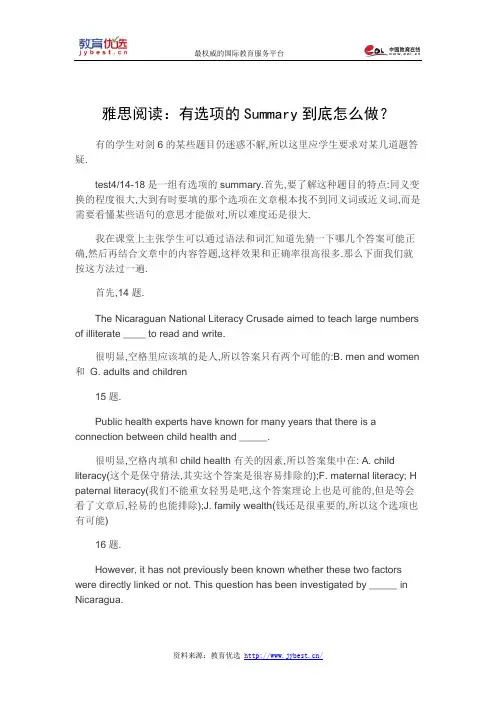
最权威的国际教育服务平台 资料来源:教育优选 http://www.jybest.cn/ 雅思阅读:有选项的Summary到底怎么做? 有的学生对剑6的某些题目仍迷惑不解,所以这里应学生要求对某几道题答疑.
test4/14-18是一组有选项的summary.首先,要了解这种题目的特点:同义变换的程度很大,大到有时要填的那个选项在文章根本找不到同义词或近义词,而是需要看懂某些语句的意思才能做对,所以难度还是很大.
我在课堂上主张学生可以通过语法和词汇知道先猜一下哪几个答案可能正确,然后再结合文章中的内容答题,这样效果和正确率很高很多.那么下面我们就按这方法过一遍.
首先,14题. The Nicaraguan National Literacy Crusade aimed to teach large numbers of illiterate ____ to read and write.
很明显,空格里应该填的是人,所以答案只有两个可能的:B. men and women 和 G. adults and children
15题. Public health experts have known for many years that there is a connection between child health and _____.
很明显,空格内填和child health有关的因素,所以答案集中在: A. child literacy(这个是保守猜法,其实这个答案是很容易排除的);F. maternal literacy; H paternal literacy(我们不能重女轻男是吧,这个答案理论上也是可能的,但是等会看了文章后,轻易的也能排除);J. family wealth(钱还是很重要的,所以这个选项也有可能)
16题. However, it has not previously been known whether these two factors were directly linked or not. This question has been investigated by _____ in Nicaragua. 最权威的国际教育服务平台 资料来源:教育优选 http://www.jybest.cn/ 这题猜起来也很容易,肯定是某位专家或组织,所以答案集中在C. an international research team和I. a National Literacy Crusade
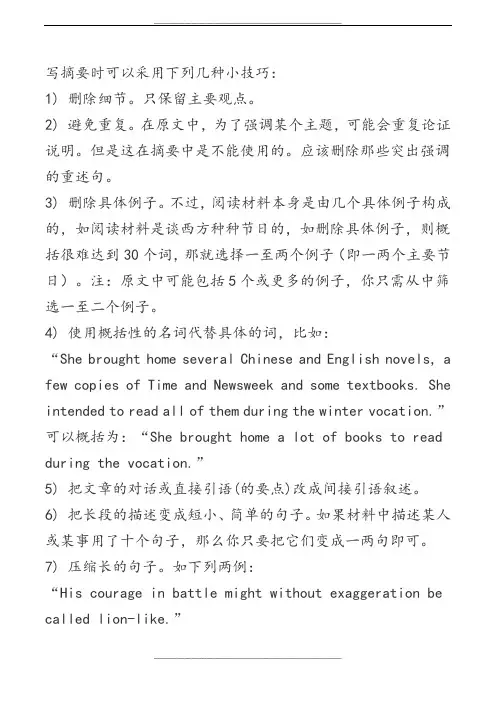
写摘要时可以采用下列几种小技巧:1) 删除细节。
只保留主要观点。
2) 避免重复。
在原文中,为了强调某个主题,可能会重复论证说明。
但是这在摘要中是不能使用的。
应该删除那些突出强调的重述句。
3) 删除具体例子。
不过,阅读材料本身是由几个具体例子构成的,如阅读材料是谈西方种种节日的,如删除具体例子,则概括很难达到30个词,那就选择一至两个例子(即一两个主要节日)。
注:原文中可能包括5个或更多的例子,你只需从中筛选一至二个例子。
4) 使用概括性的名词代替具体的词,比如:“She brought home several Chinese and English novels, a few copies of Time and Newsweek and some textbooks. She intended to read all of them during the winter vocation.”可以概括为:“She brought home a lot of books to read during the vocation.”5) 把文章的对话或直接引语(的要点)改成间接引语叙述。
6) 把长段的描述变成短小、简单的句子。
如果材料中描述某人或某事用了十个句子,那么你只要把它们变成一两句即可。
7) 压缩长的句子。
如下列两例:“His courage in battle might without exaggeration be called lion-like.”可以概括为:“He was very brave in battle.”“He was hard up for money and was being pressed by his creditor.”可以概括为:“He was in financial difficulties.”8) 你还可以使用词组代替整句或者从句。
“Beautiful mountains like Mount Tai, Lushan Mountain, and Mount Huang, were visited by only a few people in the past. Today, better wages, holidays with pay, new hotels on these mountains, and better train and bus services, have brought them within reach of many who never thought of visiting them ten years ago.”可以概括为:”Beautiful mountains like Mount Tai, once visited by only a few people, are today accessible to many, thanks to better wages, paid holidays, new hotels and better transportation services.”9) 文章中的第一人称说的话通常在摘要中转换成第三人称,从而把大段的对白简化,比如:Kate looked at Paul disapprovingly: You use much too much salt on your food, Paul —it’s not good for you!” Paul put down his knife and frowned:”Why on earth not! If you didn’t have salt on your food it would taste awful… like eating cardboard or sand… just imagine bread without saltin it, or potatoes or pasta cooked without salt!” Kate was patient. She didn’t want to quarrel with Paul. She wanted to persuade him. She said firmly:”But too much salt is bad for you. It cause high blood pressure and latter on, heart-attacks. It also disguises the taste of food, the real tastes which are much more subtle than salt, and which we have lost the sensitivity to appreciate any more.”可以用第三人称概括为:Kate suggested to Paul that he should eat less salt. She thought that eating too much salt would do hard to Paul’s health and that it could reduce the real tastes of food. But Paul disagreed. He said that food without salt would be tasteless.II.练习篇---- 学以致用1,Then, you can think of away to make both sides happy. Here are some tips1)Make time to talk. You could talk about your school life and your plans for the future.2)..Keep a diary. It can help you understand more about yourself and your feelings.3). Show your parents you are growing up. Wash your own clothes and help around the house.Summary: There are some tips for children to follow so that they can get on well with their parents.2. Sometimes, kids don’t think their parents are fair to them. When you want to dress in a modern way, your mum doesn’t like you to wear a mini-skirt. When you are making phone calls to friends, they ask whether you’re speaking to a boy or a girl.Summary: It is quite natural that we children look at the same problem differently from our parents.3. Kate looked at Paul disapprovingly, “You use too much salt on your food, Paul. It’s not at all good for you!” Paul put downhis knife and frowned, “Why on earth not! If you didn’t have salt on you r food it would taste awful…like eating wood or sand…just imagine bread without salt in it!”Summary: Kate suggested that Paul should eat less salt. But Paul disagreed. He said that food without salt would be tasteless.4. She brought home several Chinese and English novels,a few copies of Time and Newsweek, and some textbooks. She intended to read all of them during the winter vacation. Summary:She brought home a lot of books and magazines to read during the vacation.Ⅲ.Task2: find out how to summarize the whole passage 段意合并法 (说明文、应用文)第一步, 通读全文, 领略大意;第二步,小结每一段的大意;第三步, 根据每一段的大意以及作者的侧重点, 综合归纳全文的大意.对于说明性或描述性短文,可以用概括性文字说明某一现象。
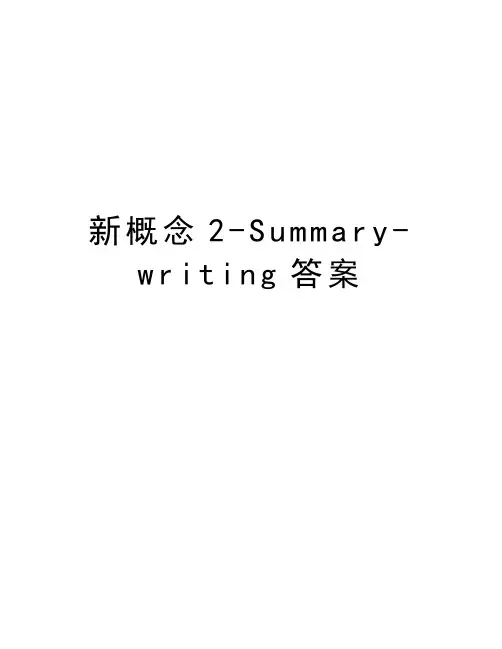
新概念2-S u m m a r y-w r i t i n g答案新概念2摘要写作答案Lesson 1The writer went to the theatre last week.He did't enjoy the play.A young man and a young woman were sitting behind him.They were talking loudly.The writer couldn't hear the actors.He turned round.He said he couldn't hear a word.The young man said,'This is a private conversation!'.(53 words)Lesson 2The writer always gets up late on Sundays.He got up late last Sunday.His aunt telephoned then.She had just arrived by train.She was coming to see him.He said,'I am still having breakfast'.His aunt was surprised.It was one o'clock.(45 words)Lesson 3Postcards always spoil the writer's holidays.He spent his holiday in Italy last summer.He tought about postcards every day.He didn't send any cards to his friends.He bought thirty-seven cards on the last day.He staied at home all day.He didn't write any cards.(47 words)Lesson 4The writer has just received a letter from his brother,Tim.Tim is an engineer.He has been in Australia for six months.He has already visited many places.He is in Alice Springs now.Tim has never been abroad before.He is enjoying his trip very much. (48 words)Lesson 5Mr.Scott has opened his second garage in Pinhurst.His first garage is inSilbury.Silbure is five miles away from Pinhurst.Mr.Scott can't get a telephone for his new garage.He has just bought twelve pigeons.They carry messages from one garage to the other in three minutes.(48 words)Lesson 6The writer has just moved to a house in Bridge Street.A beggar knocked at her door yesterday.He sang songs.The writer gave him a meal and a glass of beer in return for this.The beggar's name is Percy Buttons.He calls at every house once a month.(50 words)Lesson 7Detectives were waiting at the airport all morning.They were expecting a valuable parcel of diamonds from South Africa.Two men took the parcel of the plane.Two detectives opened it.The parcel was full of stones and sand.(39 words)Lesson 8Joe Sanders has the best garden in town.He wins 'The Nicest GardenCompetition'each year.Bill has a fine garden.Joe's is better.The writer's garden is terrible.He always win a little prize for the competition.(37 words)Lesson 9We went to the Town Hall on New Year's Eve.There were a lot of people there.The Town Hall clock will strike twelve in twenty minutes.At five to twelve,it stopped.It refused to welcome the New Year.The crowd began to laugh and sing.(46 words)Lesson 10We own an old clavichord.It was made in 1681.My grandfather bought the instrument many years ago.A visitor damaged it recently.She tried to play jazz on it.She broke two of the strings.My father's friend is repairing it now.(45 words)Lesson 11I was having dinner at a restaurant.I see Tony Steele after a while.He always borrows money from his friends.Tony sat at my table.I asked him to lend me twenty pounds.He gave me the money at once.He wanted me to pay for his dinner.(49 words)Lesson 12We'll meet Captain Charles Alison at Portsmouth Harbour eary tomorrow moring.He will be in his small boat,Topsail.He will leave at eight o'clock.We'll say goodbye to him.He will take part in an importantrace across the Atlantic.(40 words)Lesson 13The Greenwood Boys are singers.They will be coming here tomorrow.Most of the young people will be meeting them at the station.They will gave five peiformances.The police will be trying to keep order as usual.(38 words)Lesson 14The writer gave a lift to a young man in the south of France last year.They greated each other in French.The writer doesn't speak any French.They sat in silence.The young man said,'Do you speak English?' at the end of the journey.He was English himself.(49 words)Lesson 15Mr.Harmsworth wanted see me.I felt nervous.I went into his office.He said business was very bad.The firm couldn't pay such large salaries.Twenty people had already left.He didn't ask me to leave.He offered me an extra thousand pounds a year!(47 words)Lesson 16Traffic police usually give you a ticket if you park your car in the wrong place.The writer found a polite note on his car in Sweden.The traffic policeman wanted him to pay attention to their street sighs.Everyone can't fail to obey a request like this.(48 words)Lesson 17My aunt Jennifer is an actress.She is over thirty years old.She often appears on the stage as a young girl.Jennifer will act the part of a girl of seventeen in a new play soon.She never tells anyone how old she really is.(46 words)Lesson 18The writer had lunch at a village pub.She couldn't find her bag after her meal.She couldn't pay the bill.The landlord soon found it for her.His dog had taken it into the garden.(36 words)Lesson 19The play was going to begin at any moment.I asked for two tickets.There were none left.Susan and I were disappointted.A man hurried to the ticket office just then.He returned two tickets.They were for next Wednesday's performance.I bought them. (45 words)Lesson 20Fishing is the writer's favourite sport.Some unlucky fisherman catch old boots and rubbish.The writer isn't not so lucky.He never catches anything.He isn't really interested in fishing.He is only interested in sitting in a boat and doing nothing at all. (44 words)Lesson 21The writer is slowly going mad.He lives near an airport.Passing planes can be heard night and day.Most of his neighbours have left their homes.He has been offered money to leave.He determined to stay here.Everyone says he must be mad.They are probably right.(49 words)Lesson 22Jane crossed the Channel last year.She threw a bottle into the sea.It contains a piece of paper with her name and address on it.She received a letter from a girl in Holland ten months later.They write to each other regularly now.They send their letters by post. (50 words)Lesson 23My sister will come to England next year.If she comes,she will get a surprise.I have a new house in the country.I have invited my sister to star with me.It is a very modern house.It has get many large rooms and a lovelygarden. (48 words) Lesson 24I had just lost fifty pounds.I felt very upset.I told the manager about it.He couldn't do anything.He began complain about this wicked world.A girl came in with the moneyjust then.She had found it outside my room.There is still some honesty in this world. (51 words)Lesson 25I arrived at a railway station in London and asked a porter the way to my hotel,but he couldn’t understand me. He understood me at last but I couldn’t understand his answer. My teacher never spoke English like that. The porter said I shall learn English soon.. Each person speaks a different language in England. They understand each other but I don’t understand them.(67 words)Lesson 26The writer studies art and paints a lot of pictures. Many people don’t really understand modern art. Paintings don’t always have a meaning. They are something pretty patterns. Young children not only appreciate modern paintings better than others,but noticed more also. The writer’s young sister went into his room yesterday and examined his new picture. He had hung it upside down and she noticed this immediately.(67 words)Lesson 27The boys put up their tent in the middle of a flied and cooked over an open fire. They told stories and sang songs after their meal but it began to rain so they crept into their tent. The boys woke up in the middle of the night. The tent was full of water so they rushed outside. A stream had formed in the field and flowed right under their tent. (68 words)Lesson 28Jasper White believes in ancient myths. Car owners always park their cars outside his gate so he has put up ‘No Parking’ signs but they haven’t paid any attention to them. He has put an ugly stone head over the gate. It is Medusa’s head. He wants her to turn cars and their owners to stone but she hasn’t done so yet.(62 words)Lesson 29Captain Ben Fawcett has bought a small Swiss aeroplane and uses it as a taxi. It is called a ‘Pilatus Porter’ . It can not only carry seven passengers, but can land anywhere also. Captain Fawcett has taken passengers to many strange places. He refused to fly a businessman to Rockall. The journey was too dangerous.(56 words)Lesson 30The writer sat by the river last Sunday. Some children were playing games nearby. One of the children kicked a ball hard and it went towards a passing boat. The man in the boat neither saw theball nor heard people shouting. The ball hit the man and the children all ran away. However, the man wasn’t angry and threw the ball back to the bank.(67 words)Lesson 31Frank Hawkins was telling me about his experiences as a young man. Frank used to work in a small shop as a boy. He used to repair bicycles there. He bought his own shop in 1958 and made spare parts for aeroplanes in his twenties. He employed a lot of people in a few years. His wife came into the room after a while. She wanted him to repair their grandson’s bicycle.(76 words)A detective watched a well-dressed woman in a large store one Monday. She bought a few small articles and then chose an expensive dress. The assistant wrapped it up for her and the woman took it with her. She didn’t pay for it so the detective arrested her. The shop assistant was her daughter. She gave her mother a free dress once a week. (66 words)Lesson 33The girl set out from the coast one afternoon and was caught in a storm. Her boat struck a rock so she jumped into the sea. She swam eight miles that night. She reached the shore early next morning. She had seen a light ahead high up on the cliffs and she climbed up. She found herself in hospital a day later.Lesson 34Dan Robinson was worried. He had received a letter from the local police. He went to the station yesterday. He isn’t worried anymore. T he police had found his bicycle. Dan was not only surprised, but amused as well. His bicycle was stolen twenty years ago. He was a boy of fifteen then.(53 words)Lesson 35Roy is finding his new job as a bus driver exciting. He saw two thieves in Catford Street recently. They were running out of a shop and Roy drove his bus straight at the thieves, so they dropped the stolen money and got into a car.Roy drove his bus into the back of it. He telephoned the police after this. Both men were arrested later.(67 words)Lesson 36Debbie Hart is going to swim across the English Channel tomorrow. She is eleven years old and is a strong swimmer. Debbie has been trained by her father. He will follow her in a small boat. Debbie’s mother will be waiting on the English coast. She swam the Channel as a girl.(48 words)Lesson 37The Olympic Games will be held in our country in four years’ time so the government will be putting up new buildings. Kurt Gunter has designed the buildings and workers will have completed the new stadium by the end of next year. The Games will be held in this country for the first time and we are looking forward to them.(66 words)Lesson 38The writer’s friend,Harrison, had spent many years in the Mediterranean but he wanted to retire in England so he bought a house. The summer that year was very bad and he complained about the weather. Harrison not only sold the house in the end , but also left the country.(50 words)Lesson 39lington refused to tell his patient ,John Gilbert whether his operation had been successful. The patient telephoned lington next day and he inquired about a certain patient,a Mr.John Gilbert.The doctor answered a number of questions about the patients and asked whether the caller was a relative then. The caller then told him who he was.Lesson 40The writer sat next to Mrs. Rumbold at the dinner party. He tried to make conversation but she was busy eating. He talked about the new play at ‘The Globe’and the holidays.She answered his questions briefly. Then he asked if she was enjoying her dinner and she answered,‘If you ate more and talked less,we would both enjoy our dinner.’(67 words)Lesson 41The wirter’s wife was trying on a hat and he didn’t like it. He sat down and waited for her.Then they began arguing again.He had bought a terrible tie the day before but his wife didn’t like it. He said,‘A man can never have too many ties.’ His wife used exactly the same argument and she bought the hat. It looked like a lighthouse.(67 words)Lesson 42We watched a snake charmer in a square in Old Delhi. He had a long pipe and two large baskets. He played a tune and the snake in one of the baskets rose to follow the movements of the pipe. Then the snake charmer played modern tunes but the snake continued to dan ce slowly. It didn’t know the difference between Indian music and jazz.(64 words)Lesson 43In 1929,the American explorer ,R.E.Byrd became the first man to fly over the South Pole. He took a lot of photographs during the flight but then ran into difficulties. His plane couldn’t get over the mountains so he orded his men to throw out two heavy food sacks. The plane then flew over the mountains and continued without further trouble.(63 words)Lesson 44Two men tried to steal Mrs.Sterling’s handbag. She was having a picnic at the time. They took the bag after a struggle and ran through the trees. She ran after them and caught up with them. The men had sat down and were going through the contents of the bag. Mrs.Sterling ran straight at them so they dropped the bag and ran away. (66 words)Lesson 45The local buther,Sam Benton,was taking his savings to the post office but he lost his wallet. Sam not only received half his money three months later,but received a note as well.The note said:‘A thief,yes,but only 50 per cent a thief!’ The thief included a note every time he sent Sam more money. The last note said: ‘I am 100 per cent honest now!’(68 words)Lesson 46The plane from London arrived at Sydney airport and workers unloaded a number of wooden boxes. They contained clothing. One of the boxes was extremely heavy so a worker opened it. He found a man on top of a pile of woolen goods. The man was arrested. He had travelled in the box from London. He had to pay 3,500 pounds. An ordinary tickets costs 2,000 pounds.(65 words)Lesson 47Mr. Ian Thompson bought a public house recently but it is haunted,so he is going tosale it. There was a strange noise in the bar one night and the room was in disorder next morning. Mr. Thompson found five empty whisky bottles. He doesn’t believe that some villagers broke into the bar and had a drink. Anybody in the village doesn’t want to the pub.(68 words)Lesson 48The dentist in the story had pulled out one of the writer’s teeth and had told him to rest for a while. He asked se veral questions but the writer couldn’t answer them. His mouth was full of cotton wool. He suddenly discovered something wrong but he couldn’t say anything. The dentist eventually removed the cotton wool from his mouth and the writer told him he had pulled out the wrong tooth.(72 words)49A young man in Teheran bought a real bed for the first time in his life. He slept on the roof of his house because the weather was hot. Three nights later, the bed was swept off the roof during a storm. The man was not only unhurt but still on his mattress. As the bed was in pieces, he carried his mattress indoors and after he had put it on the floor he went back to sleep50The writer wanted to go to Woodford Green but as he did not know the way, the conductor promised to tell him where to get off. When they arrived at the bus terminus, the writer asked if they were at Woodford Green. The conductor then realized that he had forgotten to put him off. The writer stayed on the bus because it was going back.51Hugh is so fat that he has gone on a diet. He has forbidden himself all the foods he likes but he has not lostweight. When the writer visited him yesterday, he hid a large parcel under his desk. The parcel contained chocolates and sweets. Hugh said that he had to reward himself occasionally because his diet was so strict.52The writer has been trying to get his new room in order all morning. This has proved difficult because he owns over a thousand books which cover every inch of floor space at the moment. His sister helped him to carry one of his old bookcases up the stairs a short while ago. She got a surprise when she saw the room, but she thought that the books made a pretty carpet.53Now that firemen have put out a big forest fire in California, they have been trying to discover its cause. There was no evidence that it was started by broken glass or a cigarette end. However a fireman has just solved the mystery. He noticed the remains of a snake which had been dropped by a bird on to some electric wires. In winding itself round the wires, the snake had sent sparks to the ground and this caused the fire.54As soon as the writer returned home from the shops she began to make some meat pies. When the telephone rang soon afterwards, her fingers were very sticky. She spent ten minutes talking to Helen Bates on the telephone. After that she looked at the mess she had made. Her fingers, the telephone and the doorknobs were covered with pastry. Just then the postman rang the doorbell. He wanted her to sign for a registered letter.55‘The Revealer’is a new machine which is used for detecting buried gold. Using this machine, a search party recently tried to find gold in a cave near the seashore. Although they examined the cave thoroughly they only found a small gold coin which was practically worthless. However many people believe that the machine may reveal56A lot of old cars entered for the race, which is held once a year. A great many loud explosions could be heard when they set off and though many cars broke down during the race, a few managed to complete the course. The winning car went downhill so quickly that its driver had a lot of difficulty trying to stop it.57Though the woman in jeans hesitated for a moment, she entered an expensive shop and asked to see a dress that was in the window. On being told by an assistant that the dress was sold, the woman returned the following morning dressed in a fur coat. The assistant was eager to serve her this time. After making him bring her almost everything in the window, the woman finally bought the dress she had first asked for.58The number of visitors to the village of Frinley has increased because there is said to be a‘cursed tree’ near the church. Since the villagers believe that if anyone picks a leaf he will die, they have asked the vicar to have the tree cut down. As the tree is a useful source of income, the vicar has refused to have the tree cut down. Meanwhile, though tourists have been picking leaves, not one of them has come to harm.59Our dog, Rex, used to sit outside the front gate and bark so that someone would open it. Ever since my husband trained him to open the gate himself, Rex has developed another bad habit. He barks when he is in the garden so that someone will let him out. After this he lets himself in and barks until someone opens the gate again. Now that my husband has removed the gate, Rex has disappeared.60The writer visited a fortune-teller at a village fair who told him that a relation was coming to see him. She added that a woman he knew well would speak to him when he left the tent and he would follow her out of the fair. This came true because his wife spoke to him when he went outside. She told him they had to meet his sister at the station and she led him out of the fair.61When the Hubble telescope was launched into space in April 1990, the pictures it sent us were very disappointing because the main mirror was faulty. Four astronauts will soon be making the necessary repairs, and eventually, pictures from the Hubble will tell us a great deal about the age and size of the universe.62It took the firemen nearly three weeks to get the forest fire under control. Now that all the great trees had been burnt, there was danger that heavy rain would cause serious floods which would destroy the surrounding villages. To prevent this, the forest authorities ordered grass-seed which was sprayed over the ground by planes for nearlya month. By the time that it began to rain, the grass had taken root in many places.63When Jeremy Hampden, who is greatly admired for his great sense of humour, was invited to make a speech at a wedding reception, he immediately agreed to do so. Since the speech contained a lot of funny stories, it was a great success. When his six-year-old daughter, Jenny, wanted to go home after his speech, Jeremy wasdisappointed. She had not enjoyed it because she did not like to see so many people laughing at him.64The tunnel, which the French engineer, Aimé Thomé, planned to build under the English Channel in 1858, would be ventilated by tall chimneys built above sea level. An Englishman, William Lowe, suggested a better plan two years later. Passing trains would solve the problem of ventilation in his proposed double railwaytunnel because they would draw in fresh air behind them. Though work began forty-two years later, it was stopped because the British feared invasion. However, the tunnel was officially opened on March 7, 1994.65After having decided to take some presents to a children's hospital, the circus owner, Jimmy Gates, dressed up as Father Christmas and set off down the main street of the city riding an elephant called Jumbo. On being told that he was holding up the traffic, Jimmy agreed to go at once but Jumbo refused to move, so fifteen policemen had to push him off the main street. As he had a good record, however, Jumbo was not arrested.66The Lancaster bomber was not too badly damaged when it crashed on a remote island in the South Pacific. Then the wreck remained undisturbed for twenty-six years until it was rediscovered in an aerial survey of the island. The French authorities had the plane packaged and moved in parts back to France, where a group of enthusiasts will be having it restored. They will have to have three of the engines rebuilt, but the fourth engine is still in perfect condition because a colony of bees had turned it into a hive and it was totally covered in beeswax.67Tazieff, the Polish scientist, went to Lake Kivu in the Congo in 1948 to observe a new volcano which he called Kituro. After taking photographs, he had to leave almost at once because a river of liquid rock threatened to surround him. He escaped just in time but he returned two days later when the volcano had become quiet. This time he climbed into the mouth of Kituro in order to take photographs and measure temperatures.68Even though Elizabeth tried to avoid meeting Nigel Dykes, she was not able to do so. As he always insisted on accompanying her, she had to think of a way of preventing him from following her around all morning. When she told him she was going to the dentist, he said he would come with her because there was always plenty to read in the waiting room.69Mr. Eames had driven successfully through heavy traffic during his third driving test when the examiner instructed him to drive out of town. He told him to suppose that a child would suddenly cross the road in front of him. Mr. Eames would have to stop the car within five feet when the examiner tapped on the window. Though he tapped loudly, Mr. Eames did not react quickly enough and was told that he had just killed the child.70A drunk suddenly wandered into the middle of the ring during a bullfight and shouted rude remarks and waved a red cap. Ignoring the matador, the bull charged at the drunk, but he stepped aside to let it pass. The crowd cheered and the drunk bowed. Just after this, three men dragged the drunk to safety while the bull looked onsympathetically before it once more turned its attention to the matador.71After the Houses of Parliament were burnt down in 1834, Sir Benjamin Hall was made responsible for the construction of a huge clock, which became known as Big Ben. It is very accurate despite its immense size, for officials from the Greenwich Observatory have the clock checked twice a day. This clock, which has rarely gone wrong, can be heard on the B. B. C. When it is striking, because microphones are connected to the clock tower.72Sir Malcolm Campbell set up a land-speed record in 1935 driving a car called Bluebird, which had been specially built for him. His average speed was incorrectly declared to be 299 miles per hour, but this mistake was corrected later. He had averaged 301 miles an hour. Years later, his son, Donald, also broke a record and his car was also called Bluebird.73A boy who played truant travelled 1, 600 miles. He hitchhiked to Dover where he slept in a boat, only to find himself in Calais the next morning. A lorry driver gave him a lift and something to eat, and the boy got off near Paris. He stopped another car but, instead of being taken to Paris, he was taken to Perpignan on the French-Spanish border. After being picked up by a policeman, he was sent home by the local authorities.74After an ancient bus had stopped by a dry river bed, a party of famous film stars descended. They were dressed in dark glasses and old clothes so as not to be recognized. Two of the actors carried some picnic things to a shady spot and everyone sat down. Just then a sheriff arrived and told them rudely that they must leave because camping was not allowed. Even when they told him who they were, he did not believe them.75A plane crashed in the mountains, but the only passengers, a young woman and her two baby daughters, were not hurt. It was midwinter and extremely cold, so the woman put the children in a case, covered them with clothes and kept close to them all night. When she heard planes early next morning, she stamped out SOS in the snow. This was seen by a pilot, who sent a radio message, and they were soon rescued by a helicopter.76To end the special news bulletin, the television announcer showed viewers the macaroni fields of Calabria, where macaroni has been grown for over six hundred years. Harvesting has begun earlier this year and the whole village has been working hard, gathering and threshing the crop before the September rains. The crop is processed in the local factory. After the harvest, the famous Calabrian macaroni-eating competition, which Signor Fratelli has won every year since 1991. will take place. That ended the news bulletin for April 1st .Lesson 77(1)Doctors have just operated on the mummy of an Egyptian woman who died in800 BC. They wanted to find out whether she died of a rare disease. After removing a section of the mummy, they sent it to a laboratory. During the operation, they unexpectedly found a small wax figure of a god. Though they were afraid the mummy would fall to pieces, it successfully survived the operation. (69 words,)(2)Doctors have just operated on the mummy of an Egyptian woman who died in800 B.C., in order to find out if she died of a rare disease. They removed a section of the mummy, which they sent to a laboratory. Inside the mummy, they unexpectedly found a small wax figure of a god. They were afraid the mummy would fall to pieces, but it survived the operation. (69 words)Lesson 78(1) Having read an article on smoking, the writer smoked his last cigarette. He did not smoke for a week and his wife suffered because he had a bad temper and a large appetite. Meanwhile friends offered him cigarettes and were amused to see him produce a packet of sweets from Iris pocket. When he went to a party, he accepted a cigarette which he was offered by a friend and since then things have returned to normal. (77 words)(2) The writer read an article on smoking and smoked his last cigarette. He did not smoke for a week and his wife suffered because of her husband's bad temper and large appetite. Whenever his friends offered him cigarettes, they were amused because he would produce a packet of sweets from his pocket. However, at a party he accepted a cigarette from a friend. Now things have returned to normal. (69 words)Lesson 79(1)The plane took off and flew low over the city. When it was slowly gainingheight, it suddenly had to return to the airport. Meanwhile the passengers were told to keep calm, After they had disembarked, they learnt that there was a very important person on board. Someone had told the police that a bomb had been planted on the plane, but though it was searched, nothing was found. Five hours later, it took off again. (76 words)(2)After having taken off, the plane flew low over file city. Although it was slowlygaining height, it had to return to the airport. During this time, the passengers were told to keep calm until they had disembarked. Later they learnt that there was a very important person on board. Because the police had been told that a bomb had been planted on the plane, it was searched. However, nothing was found, so five hours later it took off again. (80 words)Lesson 80。
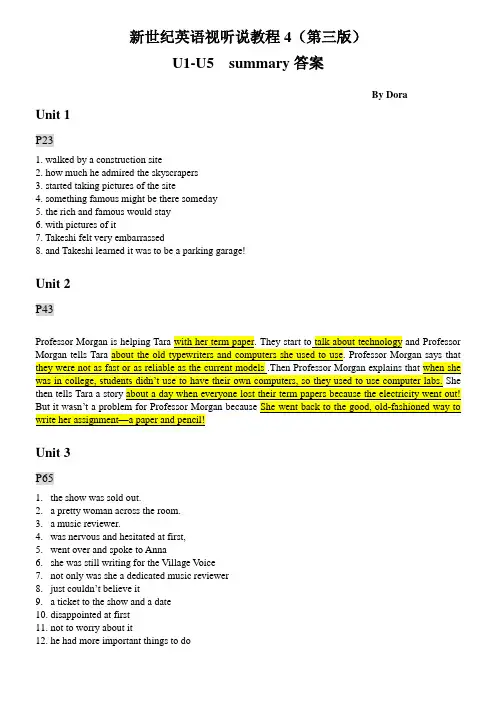
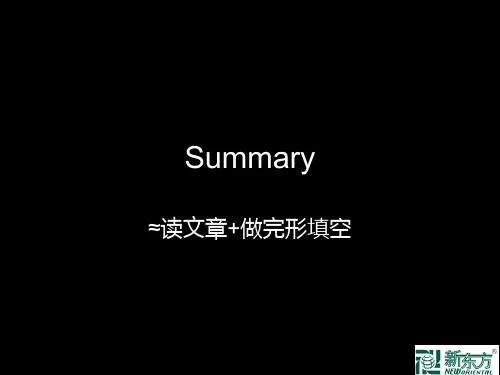
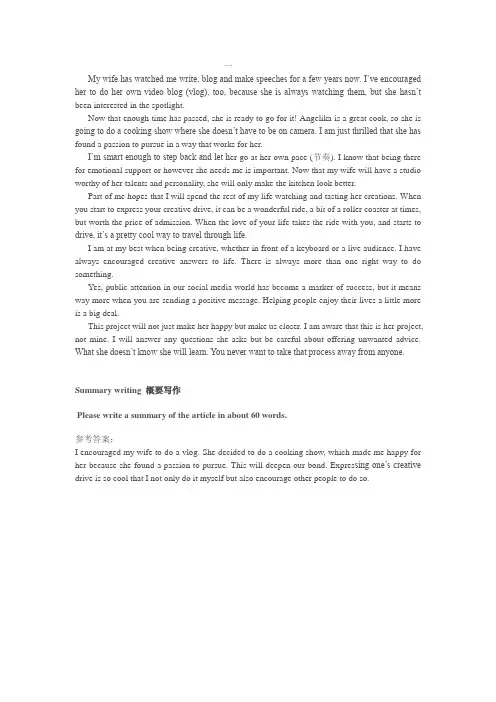
一My wife has watched me write, blog and make speeches for a few years now. I’ve encouraged her to do her own video blog (vlog), too, because she is always watching them, but she hasn’t been interested in the spotlight.Now that enough time has passed, she is ready to go for it! Angelika is a great cook, so she is going to do a cooking show where she doesn’t have to be on camera. I am just thrilled that she has found a passion to pursue in a way that works for her.I’m smart enough to step back and let h er go at her own pace (节奏). I know that being there for emotional support or however she needs me is important. Now that my wife will have a studio worthy of her talents and personality, she will only make the kitchen look better.Part of me hopes that I will spend the rest of my life watching and tasting her creations. When you start to express your creative drive, it can be a wonderful ride, a bit of a roller coaster at times, but worth the price of admission. When the love of your life takes the ride with you, and starts to drive, it’s a pretty cool way to travel through life.I am at my best when being creative, whether in front of a keyboard or a live audience. I have always encouraged creative answers to life. There is always more than one right way to do something.Yes, public attention in our social media world has become a marker of success, but it means way more when you are sending a positive message. Helping people enjoy their lives a little more is a big deal.This project will not just make her happy but make us closer. I am aware that this is her project, not mine. I will answer any questions she asks but be careful about offering unwanted advice. What she doesn’t know she will learn. You never want to take that process away from anyone.Summary writing 概要写作Please write a summary of the article in about 60 words.参考答案:I encouraged my wife to do a vlog. She decided to do a cooking show, which made me happy for her because she found a passion to pursue. This will deepen our bond. Expres sing one’s creative drive is so cool that I not only do it myself but also encourage other people to do so.二The older I get, the more I learn that our quality of life isn’t dependent on what we’ve been given.Rather, our quality of life is dependent on what we choose to create.Every day, we are creating our life.We are choosing how to spend our time, what words to say out loud and how to care for ourselves.And with all these choices, we are creating our life.Creating a good life requires you to choose how you spend your time well.You should be doing things that give you pleasure or satisfaction. But first, you have to figure out what it is that you enjoy doing.For instance, I enjoy reading, writing and ballroom dancing. On days when I’m able to do at least one of those activities, I feel quite good.However, if my free time gets taken up by serving other people’s interests, I feel frustrated.That is why you have to guard your free time. We all have parts of our day that are spent doing things that we have to do, such as our job or schoolwork.So, our limited free time is precious indeed. But our free time is where we have the opportunity to create our life.As a result, the questions you should be asking yourself every day are these:What kind of day am I creating today? Will I spend my time arguing with others and feeling frustrated? Or, will I do something with my time that I truly enjoy, such as reading a book or going dancing with my friends?We have so many beautiful choices when it comes to spending our free time.The bottom line is this: We choose what kind of life we will live. How we choose to spend our free time is in our hands.Whether we spend our time with kind or unkind people is in our hands. And the choices that we make determine the kind of life that we live.This week, consider whether you’re making the right choices so that you can create a better life for yourself.Make sure you plan your free time carefully.A good life doesn’t just happen –it’s something that we must create.Summary writing 概要写作Please write a summary of the article in about 60 words.参考答案:The quality of our life isn’t dependent on what we’ve been given but what we choose to create. By making the right choices and spending our time well, we can create a better life for ourselves.三My neighbor Stu is a car guy. He toys with (摆弄) details and drives his new Range Rover (路虎揽胜) with such pride; it’s like a member of the family. On most days, rain or shine, you can find him working on his car. It’s his thing, and I appreciate it, but it kind of makes me look bad because our SUV has seen much better days.That being said, I’m not a car guy anymore. Still, when Stu looks over his baby, I’ve often been tempted to say, “Next time you’re doing your car, let me know, and I’ll bring mine over.”Well, recently, there was Stu out front next to h is Rover. He said, “Let’s do it now,” so I pulled my classic into his driveway, and we started going at it like it was the first car either of us ever owned.Stu got out the blower (鼓风机), and I followed him with a rag (抹布) and cleaning and conditioning (保养) stuff that I’ve had in the garage. It took us a couple of hours, but the result was a great gift for my wife. Plus, I was now friends with my neighbor.We’ve always had a neighborly relationship. As we talked about cars, music and boats, we bonded. I get him: He likes things that go fast, and I appreciate the rush because I once chased it myself.Finding things in common makes for good relationships, and from that, you can build a friendship. That couple of hours was a great connecting experience.I’ve d ropped off a thank-you note because I want him to know that he has made a difference in my life. My day was better because he extended himself to me.I look forward to seeing how our friendship evolves. We have been there for each other in a couple of neighborhood emergencies, but now there is a deeper connection.You always want to know your neighbors. It’s nice when you can count on others to do the neighborly thing and be there for you when necessary. Knowing that just makes your life a little bit nicer, kind of like my car.Summary writing 概要写作Please write a summary of the article in about 60 words.参考答案:My neighbor Stu and I have built a friendship by doing things together. Recently, we worked on our cars together and also had a pleasant talk. It was a great connecting experience, through which we got to know each other better. We have helped each other in several neighborhood emergencies. It’s nice to know that there is someone you can count on when necessary.四A dear friend sent me a letter and handmade card in the mail today. On the outside of the card was a cutout (剪下来的图形) picture of a hummingbird (蜂鸟) in mid-flight. With its wings, it flew deep into a flower. Below it was a quote (引述) by Russian writer Fyodor Dostoyevsky: “The world will be saved by beauty.” I smiled with both my face and heart when I saw it.Looking at it reminded me of all the beauty in this world. I thought about the beautiful, green forested mountains of my home. I thought of the fields of summer wildflowers blessing (祝福) the world with their colors. I thought of the blue oceans that stretched from horizon (地平线) to horizon. I thought of the sunsets in the desert with their deep, rich reds and glorious (灿烂的) golds. I thought of the endless variety of animals: green hummingbirds, white polar bears, red birds, gray wolves and blinking lightning bugs. I thought of the silver moon smiling down from the sky surrounded by a sea of stars.Yet, I knew that it wasn’t the beauty of any of these things that would save the world. It was instead the beauty of human souls filled with light and love. It was these souls so full of love for each other and for this world that would save our planet. It was this love working through people that would make this world the place it was truly meant to be in the end.My friend who sent me the card is one of these people. She, her husband and her family are going through so many struggles right now. Still, she continues to share her love and make this world a better place every single day. She continues to work to save our home by giving it the beauty of her soul. She continues to shine her light with her life. May we all do the same.Summary writing 概要写作Please write a summary of the article in about 60 words.参考答案The quote in the handmade card from my friend reminded me of the beauty of the world. It not only reminded me of the natural beauty of the world but also the beautiful human souls filled with love. I think kindness and love among people will save the world and make it a better place.五Paws walk across my keyboard, and my cat Monty nests himself on my lap, unaware of the world beyond our garden fence (栅栏). In these uncertain times of the pandemic, the company of animals is needed more than ever. To the delight of our cats, dogs and all pets in between, staying at home is an opportunity to give them our undivided (一心一意的) attention. In return, they provide us with a much-needed source of joy.Pet ownership (饲养宠物) is well known to help settle anxiety, reduce loneliness and lift moods. Even as we spend an unprecedented (空前的) amount of time in isolation, pets are still acting as gateways (渠道) to building a sense of community as people share pictures of their beloved companions (伙伴) online in an effort to raise spirits.It is in such times that we realize just how much our pets matter as part of the family. As a long-term cat lady, I have never questioned that a pet is a cherished (珍爱的) member of the household. Our pets can be as valuable as our human family members in teaching us about ourselves and how to approach the world. In short, our animals’ love and loyal ty are unique.As such, the death of a pet can feel as sad as that of a close friend or family member. The grief that accompanies it remains something frequently seen as shameful, and many admit to requesting time off work without being honest about why. However, with the loss of a pet comes an emptiness where their unconditional devotion once was, and moments in the day once dedicated to their care become suddenly unoccupied. It is a very real feeling that only provides further proof to their status as family.Vet (兽医) and author James Herriot wrote, “If having a soul means being able to feel love, loyalty and gratitude, animals are better off than a lot of humans.” Pets are an additional member of the family, and now more than ever, they can serve as models for the kind of basic humanity we ought to be extending to a destabilized (不稳定的) world.Summary writing 概要写作Please write a summary of the article in about 60 words.参考答案:Pets and their owners mutually need each other. Pets long for their owners’ att ention while their owners enjoy their company. Raising a pet has many benefits, particularly during tough times. Pets lift people’s spirits and make them feel good. Their love and loyalty to their owners make them as important as family members. They show us the humanity that ought to be extended to the world.。
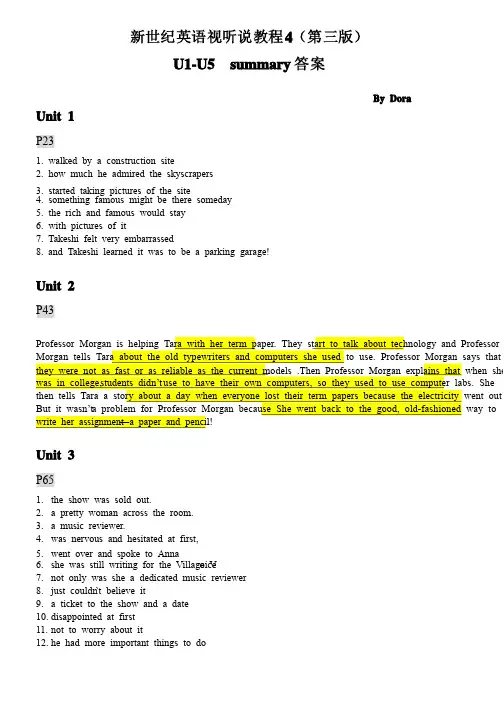
新世纪英语视听说教程4(第三版)U1-U5 summary答案By DoraUnit 1P23 1. walked by a construction site 2. how much he admired the skyscrapers 3. started taking pictures of the site 4. something famous might be there someday 5. the rich and famous would stay 6. with pictures of it 7. Takeshi felt very embarrassed 8. and Takeshi learned it was to be a parking garage! Unit 2P43 Professor Morgan is helping Tara with her term paper. They start to talk about technology and Professor Morgan tells Tara about the old typewriters and computers she used to use. Professor Morgan says that they were not as fast or as reliable as the current models .Then Professor Morgan explains that when she was in college, students didn’t use to have their own computers, so they used to use computer labs. She then tells Tara a story about a day when everyone lost their term papers because the electricity went out! But it wasn’t a problem for Professor Morgan because She went back to the good, old-fashioned way to write her assignment—a paper and pencil! Unit 3P65 1.the show was sold out. 2.a pretty woman across the room. 3.a music reviewer. 4.was nervous and hesitated at first, 5.went over and spoke to Anna oice 6.she was still writing for the Village V7.not only was she a dedicated music reviewer 8.just couldn’t believe it 9.a ticket to the show and a date 10.disappointed at first 11.not to worry about it 12.he had more important things to do Unit 4 P87 Claudia had an interview with Ms. Ms. Li Li Li for for for a software-sales position. When asked about a software-sales position. When asked about her experience, Claudia said she had been training people to use a similar software at her current job. Claudia also noted her achievements, saying she had won many sales awards. After what was quite a successful interview, Ms. Ms. Li Li Li decided decided decided that that that Claudia Claudia Claudia was was was the the the right right right person person person for for for the the the job. job. job. However, However, However, when when when Ms. Ms. Ms. Li Li Li called called called to to to offer offer Claudia the position, she had to leave a message with Tara as Claudia was unavailable. Claudia got so excited when Tara told her about the call that she almost fell over the sofa trying to get to the phone! Unit 5 P109 1. shoot a TV commercial 2. starring 3. show off 4. elaborated on how well each piece was made 5. fall asleep 6. failed to help him with 7. hire Takeshi to make five more commercials 。
雅思阅读题型归纳:Summary摘要题(Summary Completion)是雅思考试一大主力题型。
按照07年、08年的统计数据,全年所有考试的题型出现比例,摘要题高居前四。
如果考虑到统计的一些误差(网络上的考试回忆并非都是专业的雅思教师所做的,一些考生会仅仅因为记得“填空”这一Summary和其他几种题型——Sentence Completion,Notes Completion,Table Completion,Flow-chart Completion,Labeling a Diagram——所共有的答案填写方式而混为一谈,统统将其称作填空),摘要题的实际出现比例可能还会更高。
对于这样一种高频的题型,众多考生的心情是很复杂的,因为对其考察方式的不了解和误解,Summary在不少考生心目中式一种具有相当难度的题型。
那么到底Summary 在雅思考试中式如何考察我们的?外在特征和内在属性有哪些?考点设计和所需技能是什么?本文中,专家将试图解答这些问题。
从广义的角度来看,笔者对于雅思阅读所有现存题型的分析基于一种“三要素内在属性分析体系”,从本文开始,我们将一直沿用这样一套方法来对各种题型逐一进行解析。
Summary是这其中的第一站。
笔者所指的三要素分别是:主旨考察or细节考察(Gist/Detail)有序考察or乱序考察(In/Out of order)全文考察or局部考察(Global/Local)雅思考试不同题型在三要素的表现各不相同,但总体上有一些倾向性。
比如对于第一要素主旨或细节,大部分题目都只考察或把重点放在细节方面;对于第二要素有序或无序来说,无序的是绝对少数;而对于第三要素全文或局部,多数题目的共性却是事前无法确知——只有当我们完成该题型之后,一般才会知道它是global 还是local的。
也就是说,多数题型在第三要素的这一共性反映了一点:即它们都既有Global类型的,也有Local类型的。